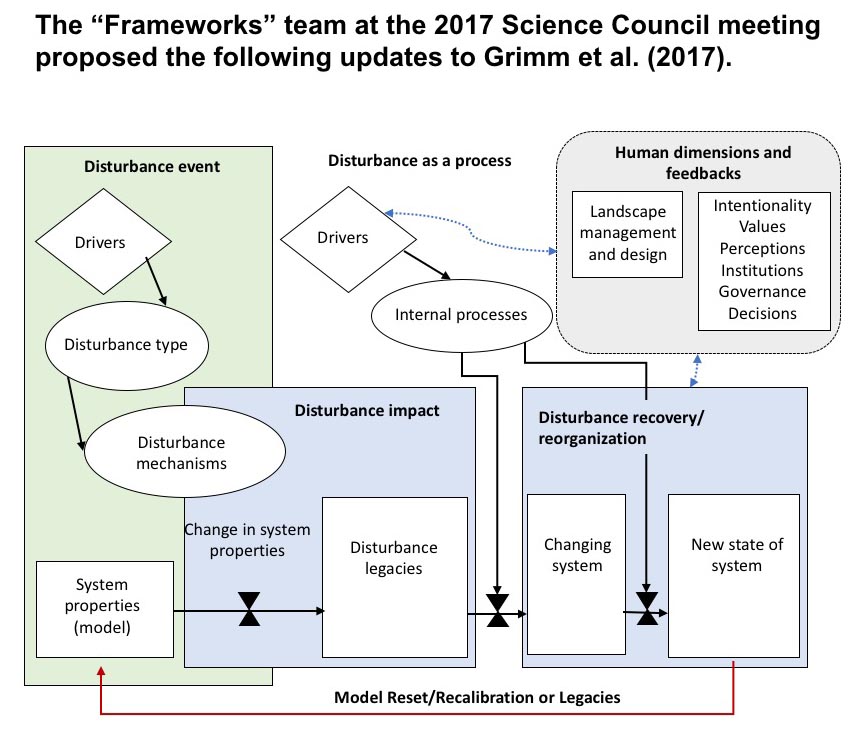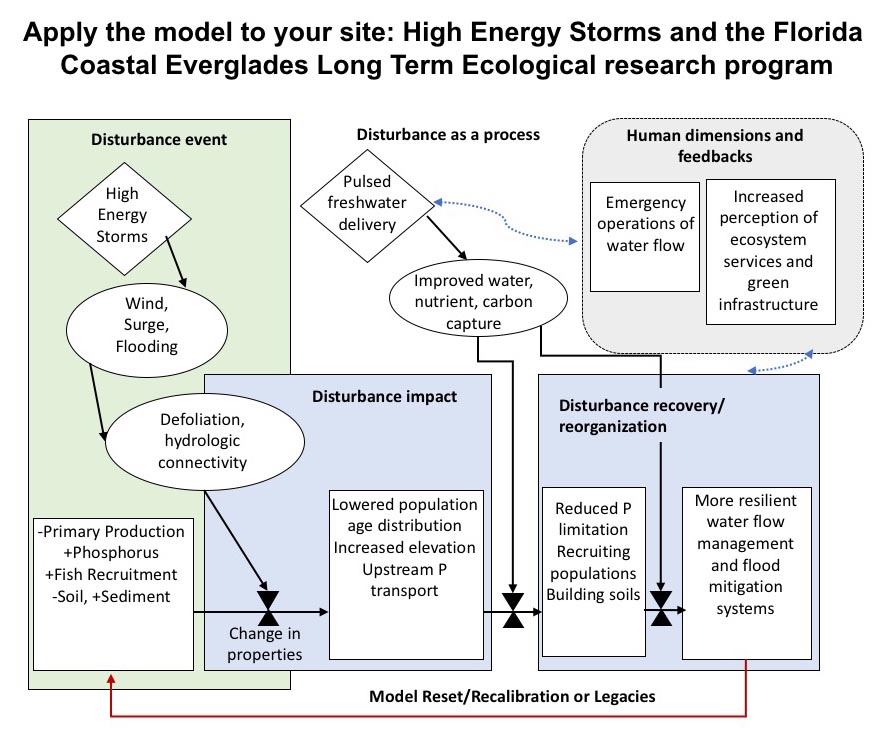Over the last several decades, disturbance has become a commonly recognized driver of the dynamics of ecological systems. Long-term ecological research is uniquely positioned to address the three challenges of disturbance:
- that events can be both positive and negative,
- that theoretically frameworks are comprehensive enough for driving empirical generality, and
- that disturbance can alter systems differently as environments change.
This interactive webinar will present a refined conceptual model for synthesizing disturbance across systems with long-term social-ecological research. We will complete the conceptual diagram for a few illustrative systems, laying the groundwork for a broader workshop at the LTER All Scientists’ Meeting. In the process, presenters will illustrate the utility of the conceptual model for building site- level understanding of disturbance outcomes, and its potential for driving insights across different types of ecosystems.

Credit: Frameworks Working Group, 2017 LTER Science Council

Credit: Frameworks Working Group LTER Science Council 2017
Two paragraphs, describing the case study shown:
High-energy storms including hurricanes represent a common disturbance to the FCE LTER. Storms impact social-ecological ecosystems through sustained high winds, marine water surges and extreme rainfall and associated flooding. In the Everglades, these drivers defoliate trees and change connectivity of ecosystems to fresh and marine water supplies. Documented immediate changes in system properties include reduced primary production, increased delivery of the limiting nutrient, phosphorus, increased fish recruitment, increased sediment elevation through storm surge deposits, and export of soils as organic carbon through estuaries. The longer-term legacies include a lowered population age distribution of plants and animals often associated with landward recruitment, increased elevation due to the inorganic storm deposits, and increased upstream tidal transport of phosphorus. These legacies influence net ecosystem productivity, improved coastal ecosystem resilience to sea level rise, and can accelerate interior-ward invasion of forests.
High-energy storms also influence urban and agricultural regions surrounding the Everglades and their interaction through flood water management. Storms can stimulate emergency water delivery actions to move water from developed lands into the interior of the Everglades. These actions are made possible through governance and infrastructure changes, with increasing recognition of the ecosystem services provided by coastal mangrove forests. These forests improve sediment, carbon, nutrient and water capture and can attenuate surge, improving resilience of coastal urban and agricultural systems. These social-ecological feedbacks to tropical storms are essential to building capacity of coastal ecosystems to sustain in the face of rapid sea level acceleration.
Relevant literature
Barr, J.G., J.D. Fuentes, M.S. DeLonge, T.L. O’Halloran, D. Barr, J.C. Zieman. 2013. Summertime influences of tidal energy advection on the surface energy balance in a mangrove forest. Biogeosciences 10: 501-511. DOI: 10.5194/bgd-10-501-2013
Barr, J.G., V. Engel, T.J. Smith, J.D. Fuentes. 2012. Hurricane disturbance and recovery of energy balance, CO2 fluxes and canopy structure in a mangrove forest of the Florida Everglades. Agricultural and Forest Meteorology 153: 54-66. DOI: 10.1016/j.agrformet.2011.07.022
Briceno, H.O., J.N. Boyer. 2010. Climatic Controls on Phytoplankton Biomass in a Sub-tropical Estuary, Florida Bay, USA. Estuaries and Coasts 33(2): 541-553. DOI: 10.1007/s12237-009-9189-1
Castañeda-Moya, E., R.R. Twilley, V.H. Rivera-Monroy, K. Zhang, S.E. Davis, M.S. Ross. 2010. Sediment and Nutrient Deposition Associated with Hurricane Wilma in Mangroves of the Florida Coastal Everglades. Estuaries and Coasts 33(1): 45-58. DOI: 10.1007/s12237-009-9242-0
Danielson, T., V.H. Rivera-Monroy, E. Castañeda-Moya, H.O. Briceno, R. Travieso, B.D. Marx, E.E. Gaiser, L. Farfan. 2017. Assessment of Everglades mangrove forest resilience: Implications for above-ground net primary productivity and carbon dynamics. Forest Ecology and Management404: 115-125. DOI: 10.1016/j.foreco.2017.08.009
Davis, S.E., J.E. Cable, D.L. Childers, C. Coronado-Molina, J.W. Day, C.D. Hittle, C.J. Madden, D. Rudnick, E. Reyes, F. Sklar. 2004. Importance of Episodic Storm Events in Controlling Ecosystem Structure and Function in a Gulf Coast Estuary. Journal of Coastal Research 20(4): 1198-1208.
Farfan, L., E. D’Sa, K. Liu, V.H. Rivera-Monroy. 2014. Tropical Cyclone Impacts on Coastal Regions: the Case of the Yucatan and the Baja California Peninsulas, Mexico. Estuaries and Coasts 37(6): 1388-1402. DOI: 10.1007/s12237-014-9797-2
Fourqurean, J.W., L.M. Rutten. 2004. The impact of Hurricane Georges on soft-bottom, backreef communities: site- and species-specific effects in south Florida seagrass beds. Bulletin of Marine Science 75(2): 239-257.
Jiang, J., D.L. DeAngelis, G. Anderson, T.J. Smith. 2014. Analysis and Simulation of Propagule Dispersal and Salinity Intrusion from Storm Surge on the Movement of a Marsh-Mangrove Ecotone in South Florida. Estuaries and Coasts 37: 24-35. DOI: 10.1007/s12237-013-9666-4
Krauss, K.W., T.W. Doyle, R.R. Twilley, T.J. Smith, K.R.T. Whelan, J.K. Sullivan. 2005. Woody Debris in the Mangrove Forests of South Florida. Biotropica 37(1): 9-15. DOI: 10.1111/j.1744-7429.2005.03058.x
Lagomasino, D., R.M. Price, D. Whitman, A. Melesse, S. Oberbauer. 2015. Spatial and temporal variability in spectral-based surface energy evapotranspiration measured from Landsat 5TM across two mangrove ecotones. Agricultural and Forest Meteorology 213: 304-316. DOI: 10.1016/j.agrformet.2014.11.017
Nodine, E., E.E. Gaiser. 2015. Seasonal differences and response to a tropical storm reflected in diatom assemblage changes in a southwest Florida watershed. Ecological Indicators 57: 139-148. DOI: 10.1016/j.ecolind.2015.04.035
Price, R.M., P.K. Swart, H.E. Willoughby. 2008. Seasonal and spatial variation in the stable isotopic composition (d18O and dD) of precipitation in south Florida. Journal of Hydrology 358: 193-205. DOI: 10.1016/j.jhydrol.2008.06.003
Ross, M.S., J.J. O’Brien, G. Ford, K. Zhang, A. Morkill. 2009. Disturbance and the rising tide: the challenge of biodiversity management on low-island ecosystems. Frontiers in Ecology and the Environment 7: 471-478. DOI: 10.1890/070221
Smith, T.J., G. Anderson, K. Balentine, G. Tiling, G.A. Ward, K. Whelan. 2009. Cumulative Impacts of Hurricanes on Florida Mangrove Ecosystems: Sediment Deposition, Storm Surges and Vegetation. Wetlands 29(1): 24-34. DOI: 10.1672/08-125.1
Smoak, J.M., J.L. Breithaupt, T.J. Smith, C.J. Sanders. 2013. Sediment accretion and organic carbon burial relative to sea-level rise and storm events in two mangrove forests in Everglades National Park. Catena 104: 58-66. DOI: 10.1016/j.catena.2012.10.009
Troxler, T., E.E. Gaiser, J.G. Barr, J.D. Fuentes, R. Jaffe, D.L. Childers, L. Collado-Vides, V.H. Rivera-Monroy, E. Castañeda-Moya, W.T. Anderson, R.M. Chambers, M. Chen, C. Coronado-Molina, S.E. Davis, V. Engel, C. Fitz, J.W. Fourqurean, T.A. Frankovich, J. Kominoski, C.J. Madden, S.L. Malone, S. Oberbauer, P.C. Olivas, J.H. Richards, C.J. Saunders, J. Schedlbauer, L.J. Scinto, F.H. Sklar, T.J. Smith, J.M. Smoak, G. Starr, R.R. Twilley, K.R.T. Whelan. 2013. Integrated carbon budget models for the Everglades terrestrial-coastal-oceanic gradient: current status and needs for inter-site comparisons. Oceanography 26: 98-107. DOI: 10.5670/oceanog.2013.51
Williams, C.J., J.N. Boyer, F.J. Jochem. 2008. Indirect hurricane effects on resource availability and microbial communities in a subtropical wetland – estuary transition zone. Estuaries and Coasts 31(1): 204-214.
Zapata-Rios, X., R. Rivero, G.M. Naja, P. Goovaerts. 2012. Spatial and temporal phosphorus distribution changes in a large wetland ecosystem. Water Resources Research 48: W09512. DOI: 10.1029/2011WR011421
